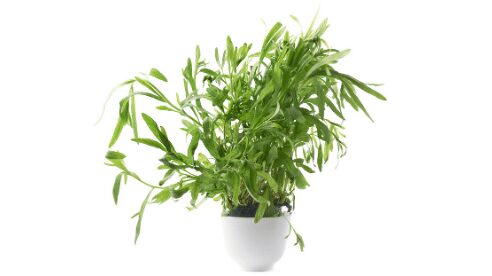Know in one minute about French tarragon plant
|
Introduction
French tarragon (Artemisia dracunculus (L.) var. sativa) is a popular aromatic herb, belonging to the family Asteraceae (Compositae). French tarragon plant should not be confused with Russian tarragon because both differ dramatically in their aroma and flavor. Russian tarragon’s stem is longer (4 to 5 feet). The leaves were similar in shape but larger and coarser, and it had no or less intense flavor. French tarragon has glossier leaves, licorice or anise or vanilla flavor which is famous in French cuisine. It can be consumed in fresh or dry form with fish, chicken, egg, also infused with vinegar to acidify sauces and pickles.
Common name
Estragon, dragon sagewort, or German tarragon
Geographical distribution
This plant is native to southern Russia in the area of the Caspian Sea (1).
Botanical description
Growing season
Summer
Height
French tarragon has bushy, branched stems that grow up to two to three feet tall.
Leaves
The leaves are shiny, slender, slightly twisted, and dark green in color.
Flower
The plant will occasionally produce small, greenish-white flowers that are sterile.
Bloom time
Summer (2).
French tarragon care
Common problems with this plant are its weedy look but its leaves are flavorsome, easy to grow, hardy, and drought-resistant. You just have to follow some basic rules such as:
1. Soil
This plant requires well-drained, sandy, loamy, light, and low in nutrients soil for best growth. A rich, acidic soil will result in poor growth, rotting roots, and a reduced flavor.
2. Light
French tarragon plant needs plenty of bright sunlight (5–6 hrs/day) and also does well in a partially sheltered position.
3. Water
Irrigate only when the top of the soil becomes dry and allows the soil to dry out between watering. Excess water or over-watering may cause rotting of roots.
4. Fertilizer
French tarragon plants are friendly and easy growing so doesn’t require a lot of nutrients. The best flavor is achieved when it’s planted in low-nutrient soil.
5. Temperature and Humidity
This plant doesn’t like intense temperatures over 90 degrees Fahrenheit and high humidity.
6. Mulch
To protect the root from cold, this plant needs mulching around the base of the plant. This process keeps the moisture near the surface of the plant and discourages root rot.
7. Pruning
Prune the French tarragon plants in early spring are necessary to remove old leaves, encourage new growth, and keep branches strong.
8. Harvesting and Storing
French tarragon (young stem tips and leaves) can be harvested as needed throughout the season. To obtain the best flavor it should be used fresh within a day or two. However, to retain the flavor of dried leaves it should be kept in airtight containers at room temperature
French tarragon plant propagation
French tarragon rarely flowers thus it produces a small amount of seed that are sterile and does not germinate. This plant is easily propagated by stem cuttings or the root division method in spring.
Make sure to cut the stems which are six to eight inches long and gently separate the roots that cause the least damage. Remove leaves from the lower third of each stem and dip the cut end into the rooting hormone.
Next plant it in a pot with potting soil which is evenly warm and moist until roots form. This plan can live for at least 3 or 4 years, but will eventually need replacing
French tarragon toxic to cats or dogs
Tarragon essential oil contains estragole and methyl eugenol which is toxic to cats and dogs. These compounds may cause vomiting and diarrhea.
French tarragon plant medicinal value or health benefits
- This plant is used in folk medicine for the treatment of cough, cold, fever, pain, amenorrhea, and dysmenorrheal.
- Intake of French tarragon helps to encourage the growth of white blood cells that boost the immune system (3).
- This herb is effective in reducing pain, swelling in the joints, and increasing the ability to handle the pain (4).
- The presence of coumarin compounds in tarragon leaves inhibits the clotting of the blood (5).
- It fights against different bacteria such as Pseudomonas aeruginosa Shigella (RSHI), Listeria monocytogenes, and Escherichia coli by damaging its cell wall (6).
- Intake of tarragon improves glucose utilization and prevents fat accumulation thus delaying the development of obesity-related risk factors. (7).
- Ingestion of tarragon is beneficial to treat nerve damage that can occur with diabetes due to long-term high blood sugar levels (8).
- Tarragon contains flavonoids that help to treat depression, stress disorders, and anxiety (9).
- Tarragon tea made by adding dry tarragon to boiling water is very effective in relieving both insomnia and hyperactivity symptoms (10).
Q&A
Is French tarragon perennial or annual?
Tarragon is perennial (in a hot climate) but is often grown as an annual (in the temperate zone). In winter, this plant takes a rest (dried or frozen) and starts a new fresh plant every spring.
Where does tarragon grow best?
This plant requires a sunny, warm, and partial sheltered position to obtain the best flavor. It is cold-resistant, heat-resistant, and drought-tolerant and can be growing in a sunny window or planted outside.
Does tarragon need full sun?
Yes, this plant needs plenty of bright sunlight (5–6 hrs/day) and also does well in a partially sheltered position.
Does tarragon come back every year?
Depending upon the climate or growing zone, it is a perennial plant that produces leaves over several years (3-4 years).
